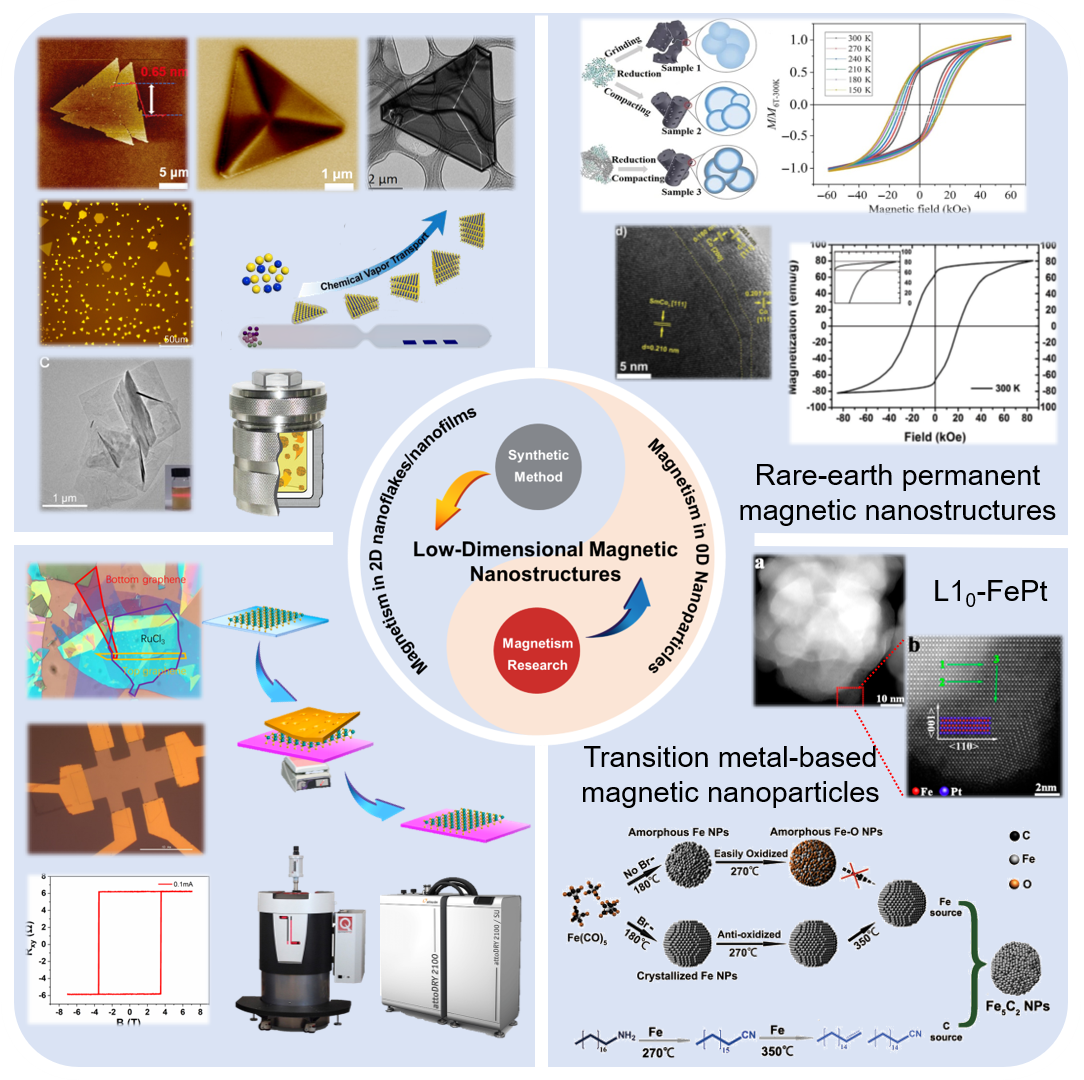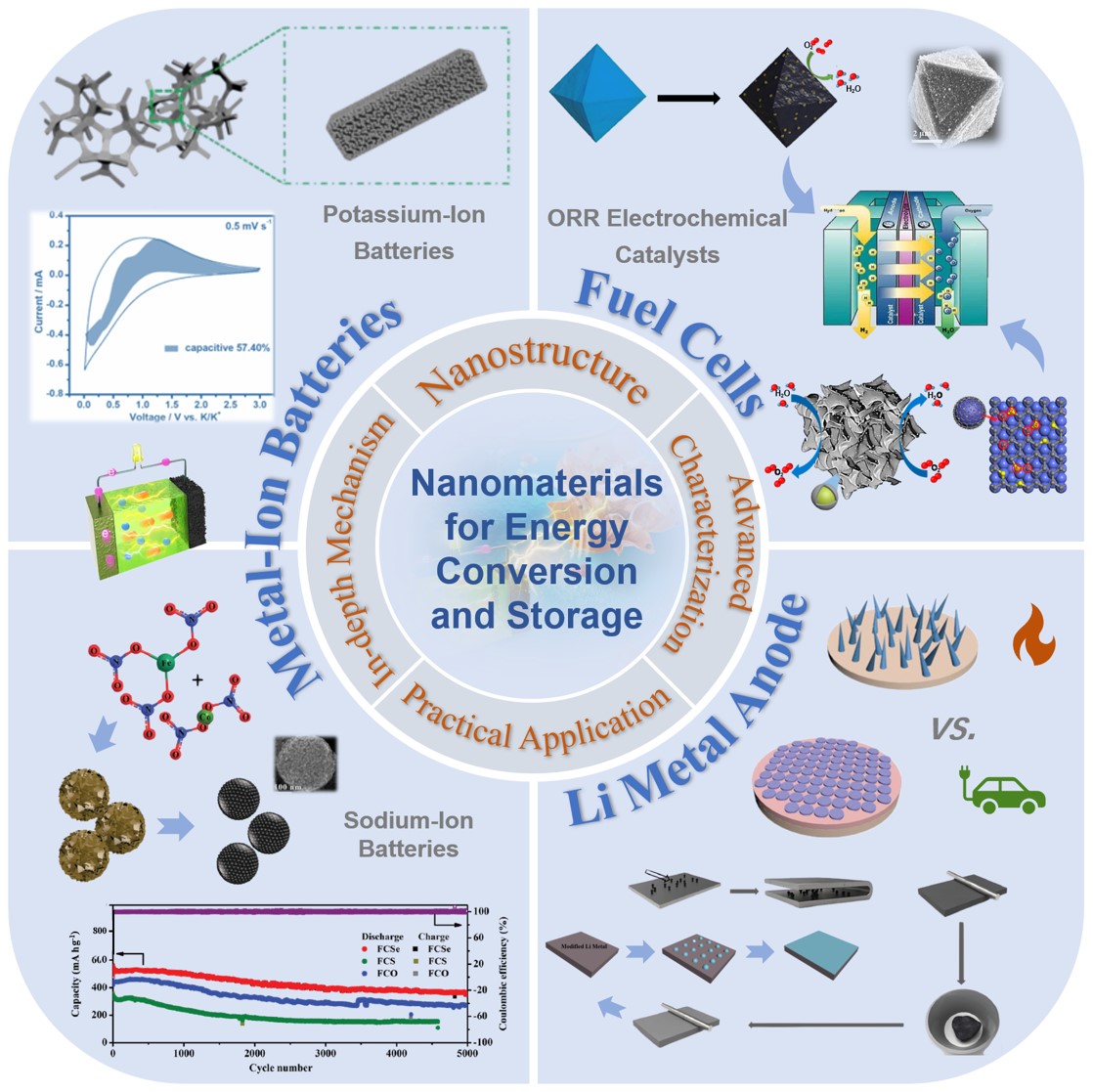| |
|
Our group research interests lie on an interdisciplinary field including Materials Science,
Chemistry, Nanotechnology and Nanomedicine: |
|
|
1. Low-Dimensional Magnetic Nanomaterials:
Magnetic nanomaterials are of great value in information storage and biomedical applications. Our group is interested in the controllable synthesis of low-dimensional magnetic nanomaterials and their heterostructures, the exploration of the effect of reaction conditions, surface structures and interface energy on the nucleation and growth process, so as to study the structure-activity relationship between interface structure, electronic structure, micromagnetic structure and macroscopic magnetic properties, thus achieving synergetic control of dimension, size, morphology, crystalline and heterogeneous interface. Regarding to 0D magnetic nanoparticles, we are mainly engaged in the chemical design, controllable synthesis and properties modulation of high performance rare-earth permanent nanomagnets and monodispersed transition metal-based magnetic nanoparticles. As for 2D magnetic nanomaterials with high Curie or Néel temperature theoretically,we are adopting both top-down and bottom-up synthetic strategies, and developing many preparation methods, such as chemical vapor deposition,electrochemical exfoliation,liquid-phase synthesis, in order to explore dimension-dependent magnetic properties and discover new fascinating physical properties in novel 2D magnetic nanomaterial systems.
|
|
|

Nat. Electron. 2023, 6, 119-125.
Nat. Commun. 2023, 14, 958.
J. Am. Chem. Soc. 2022, 144, 19758−19769.
Adv. Mater. 2022, 34, 2108847.
Adv. Mater. 2022, 34, 2200117.
Nano Lett. 2022, 22, 1242–1250.
Matter. 2022, 5, 291−301.
Chem. Sci. 2022, 13, 203−209.
Natl. Sci. Rev. 2020, 7, 841–848.
Adv.Sci. 2020, 7, 2001080.
Trends in Chem. 2020, 2, 163–173. 
Nano Res. 2020, 13, 1141.
Acc. Chem. Res. 2018, 51, 404.
Nano Lett. 2018, 18, 7839.
Chem. Sci. 2017, 8, 473–481.
Angew. Chem. Int. Edit, 2014, 53, 2176-2180.
Chem. Soc. Rev. 2014, 43, 8098–8113. 
Sci.Rep, 2013, 3, 3542.
J. Am. Chem. Soc. 2012, 134, 15814-15821.
Adv. Mater. 2010, 22, 2729-2742.
Adv. Mater. 2007, 19, 3349-3352. 
J. Am. Chem. Soc. 2007, 129, 8698-8699. 
Angew. Chem. Int. Ed. 2007, 46, 6333-6335.
Angew. Chem. Int. Ed. 2007, 46, 6329-6332.
|
|
|
2. Biomedical applications of magnetic nanomaterials
:
Magnetic nanomaterials, with their unique magnetic and optical properties, small size effect and controlled surface modification capacity, have significant application potential in biomedical fields. According to the present challenge of cancer diagnosis and treatment, our group has made the best of the peculiar chemical and physical properties of magnetic nanomaterials to develop the multifunctionally biological nanoprobe, highlighting the advantages of magnetic nanomaterials-mediated imaging-guided treatment, drug delivery system and nanoenzyme in multiscale synergistic therapies. Meanwhile, based on the magnetic nanomaterial platform, our group also has explored the application of immune activation and nanorobots in controlled cancer diagnosis and treatment.
|
|
|

Sci. Adv. 2022, 8, eabn3883.
J. Am. Chem. Soc. 2022, 144, 19884−19895.
Chem. Rev. 2022, 122, 5411−5475.
CCS Chem. 2022, 5, 469-485.
ACS Nano 2022, 16, 11862-11875.
Adv. Healthcare Mater. 2022, 11, 2201240.
Aggregate. 2021, 2, e18.
Sci. Adv. 2020, 6, eabc8733.
Adv. Healthcare Mater. 2020, 2000845.
Nat. Commun. 2019, 10, 4418.
ACS Nano 2019, 13, 10002.
ACS Nano 2017, 11, 9239-9248.
ACS Nano 2016, 10,159-169.
Adv. Mater. 2014, 26, 4114-4120.
Small 2014, 7,1245–1249.
Adv. Mater. 2010, 22, 2729-2742.
Adv. Mater. 2007, 19, 3163-3166.
| |
| |
3. Application of functional nanomaterials in new energy field
:
High-performance electrochemical energy will become an important part of the social energy structure. In view of the great demand of the new generation of electrochemical energy, we are committed to developing new battery electrode materials and nanocatalysts. We design and construct a variety of nanostructures to be applied to different new energy devices, such as metal ion batteries (lithium, sodium, potassium, etc.), lithium metal anode, and fuel cells. We combine various advanced characterization methods and theoretical calculations to deeply explore the reaction mechanism, and on this basis, solve the current bottleneck problems and promote the industrialization process of new energy materials and devices.
|
|
| |

Adv. Energy Mater. 2023, 22043.
ACS Materials Lett. 2023, 5, 1488−1496.
ACS Nano 2022, 16, 21443–21451.
J. Energy Chem. 2022, 68, 184-194.
Carbon Energy. 2022, 4, 776-819.
Adv. Energy Mater. 2021, 11, 2003823.
Adv. Funct. Mater. 2021, 31, 2100186.
ACS Appl. Mater. Interfaces 2021, 13, 6989−7003.
Angew. Chem. Int. Ed. 2021, 60, 181−185.
J. Mat. Chem. A 2021, 9, 8561−8567.
Nat. Commun. 2020, 11, 1-10.
Mater. Today. 2020, 35, 131-167.
ACS Nano 2020, 14, 8495-8507.
Adv. Energy Mater. 2020, 10, 1900375.
Adv. Funct. Mater. 2019, 29, 1808468.
Adv. Funct. Mater. 2019, 29, 1807485.
Nano Energy 2019, 65, 103989.
ACS Energy Lett. 2018, 3, 2914-2920.
Adv. Mater. 2018, 30, 1802745.
ACS Catal. 2017, 7, 5661−5667.
Nano Energy 2016, 28, 346–355.
Nano Energy 2015, 11, 755–765.
Nano Today 2014, 9, 668-683.
Adv. Funct. Mater. 2014, 24, 2930-2937.
ACS Nano 2013, 7, 10307-10318.
Adv Mater. 2013, 25, 4932-4937.
Nano Energy 2013, 2, 88-97.
J. Am. Chem. Soc. 2012, 134, 15814–15821.
|
|
|
|









